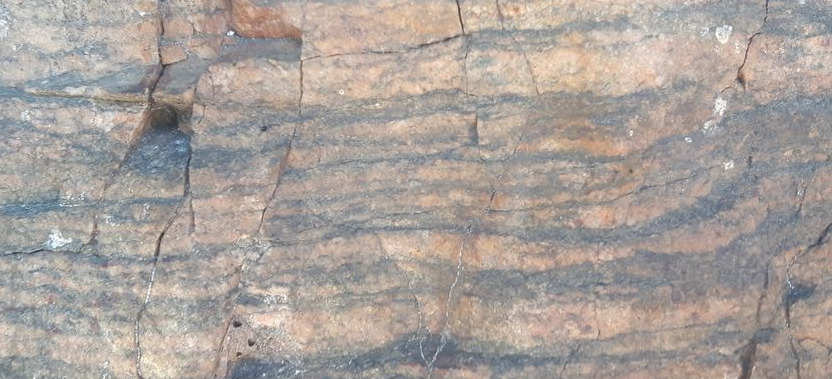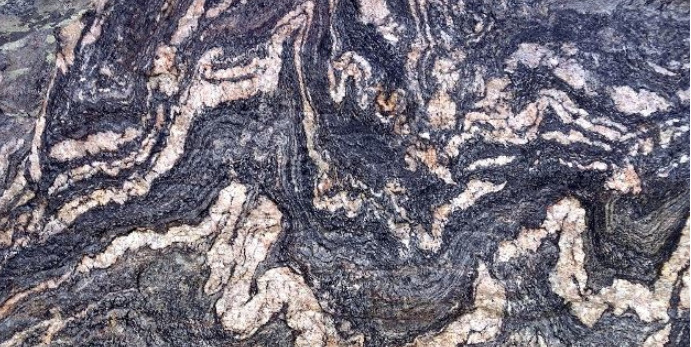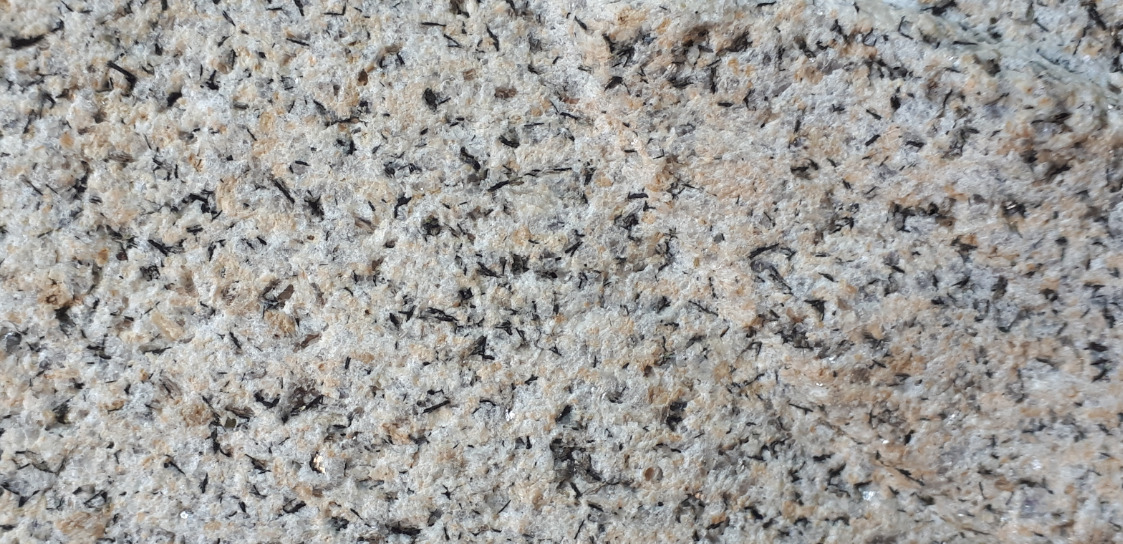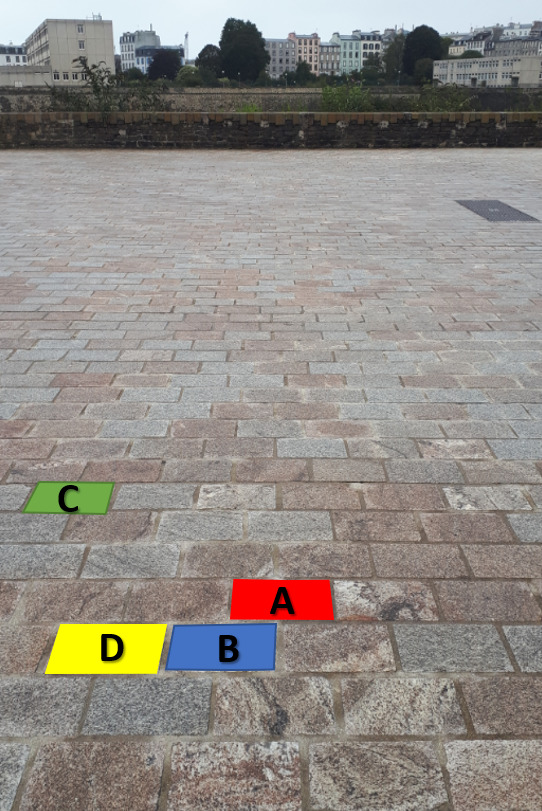
La Earthcache / The Earthcache
► Roches QFM, une composition minérale pour les rassembler
Les roches QFM ont comme point commun d'avoir une nature entièrement cristalline, une texture grenue (cristaux visibles à l’œil nu) et une composition chimique majoritaire basée sur 3 minéraux :
- Q comme Quartz (SiO2) : translucide parfois transparent, ce minéral est gris sans facette.
- F comme Feldspath : minéral opaque à translucide, blanchâtre ou rose (orthose) selon la présence d’oxydes de fer et souvent en macles (forme rectangulaire).
- M comme Mica : ce minéral se présente en fines paillettes brillantes selon deux formes :
- la biotite, mica noir brillant de composition ferromagnésienne.
- la muscovite, mica blanc brillant au soleil avec un aspect nacré.

A ces couleurs noir/gris/blanc/rose des cristaux sains peut s'ajouter une nouvelle couleur en cas d'altération par l'eau des minéraux ferreux (biotite). L'oxydation du fer entraine une coloration rouge-rouille à la roche ; c'est le phénomène de rubéfaction.

► Des roches avec une orientation différente (ou pas du tout !)
La disposition et l'orientation des minéraux QFM permet de déterminer 3 types de roches.
~ Orthogneiss acide
L'Orthogneiss est une roche massive à grains fins visibles à l'oeil nu .
Elle provient de la transformation par métamorphisme d'une roche QFM généralement granitique.
La contrainte des forces compressives va réarranger les minéraux de la roche en mettant en place une foliation avec une alternance de petits lits clairs (quartz et feldspath) et de fins niveaux sombres (biotite voir amphibole).

~ Migmatite
Si la température monte, l'orthogneiss peut subit une fusion partielle du quartz et des feldspaths puis leur cristallisation fractionnée avec ségrégation minérale, avec deux niveaux.
~ Les Métatexites, 1er stade à fusion minoritaire, se présentent sous une forme rubanée avec une alternance de lits clairs ayant fondu (leucosome) et de lits sombres n'ayant pas fondu (mélanosome).

~ Les Diatexites, dernier stade avant la fusion totale ont un aspect granitique prononcé et une perte de la foliation. Les cristaux du leucosome sont bien visibles avec une structure cloisonnée. Il reste des zones plus sombres avec une proportion significative de biotite.

~ Granite
C'est la roche QFM par excellence, qui se caractérise par une origine magmatique, c'est à dire de la cristallisation d'une roche liquide.
Cette roche sont généralement des roches primaires avec un magma venant du manteau supérieur, mais peuvent être aussi le produit ultime du métamorphisme par fusion totale d'une roche métamorphique acide (granite d'anatexie).
Sa caractéristique la différenciant est de n'avoir aucune orientation minérale.

► Chez les cristaux QFM, la taille ça compte !
La texture d'une roche QFM caractérise leur taille relative et absolue.
La taille des cristaux est directement liée à la vitesse de refroidissement. Plus le refroidissement est lent, plus les cristaux formés sont gros.
La texture générale d'une roche QFM grenue se déclinent en plusieurs formes. Par exemple :
- Texture grenue équante : les cristaux sont de même taille (de l'ordre du mm ou du cm).
- Texture grenue porphyroïde : de gros cristaux de taille centimétrique automorphes souvent préexistant dans le magma sont dispersés parmi des cristaux bien plus petits (de 5 à 10 fois).
- Texture pegmatitique : minéraux de taille centimétrique à pluri-centimétrique, quartz et feldspath automorphes, avec ou sans micas.

► QFM rocks, a mineral composition to bring them together
The common feature of QFM rocks is that they are entirely crystalline in nature, have a grainy texture (crystals visible to the naked eye) and a predominant chemical composition based on 3 minerals:
- Q for Quartz (SiO2): translucent sometimes transparent, this mineral is gray without facet.
- F for Feldspar: opaque to translucent, whitish or pink mineral (orthosis) depending on the presence of iron oxides and often twins (rectangular shape).
- M for Mica: this mineral is presented in fine shiny flakes in two forms:
- biotite, shiny black mica of ferromagnesian composition.
- muscovite, white mica shining in the sun with a pearly appearance.
To these black / gray / white / pink colors healthy crystals can be added a new color in case of water alteration of ferrous minerals (biotite). The oxidation of iron causes a red-rust coloration to the rock; it is the phenomenon of reddening.
► Rocks with a different orientation (or not at all!)
The arrangement and orientation of QFM minerals allows to determine 3 types of rocks.
~ Acid orthogneiss
Orthogneiss is a massive fine-grained rock visible to the naked eye.
It comes from the transformation by metamorphism of a generally granitic QFM rock.
The constraint of the compressive forces will rearrange the minerals of the rock by setting up a foliation with an alternation of small clear beds (quartz and feldspar) and fine dark levels (biotite see amphibole).
~ Migmatite
If the temperature rises, orthogneiss can undergo partial fusion of quartz and feldspars and their fractional crystallization with mineral segregation, with two levels.
~ Métatexites, 1st stage with minority fusion, appear in a banded form with an alternation of clear beds that have melted (leucosome) and dark beds that have not melted (melanosome).
~ The Diatexites, the last stage before total fusion, have a pronounced granite appearance and a loss of foliation. The leucosome crystals are clearly visible with a septate structure. Darker areas remain with a significant proportion of biotite.
~ Granite
It is the QFM rock par excellence, which is characterized by a magmatic origin, ie the crystallization of a liquid rock.
These rocks are generally primary rocks with a magma coming from the upper mantle, but can also be the ultimate product of the metamorphism by total fusion of an acid metamorphic rock (anatexic granite).
Its distinguishing characteristic is that it has no mineral orientation.
► With QFM crystals, size matters!
The texture of a QFM rock characterizes their relative and absolute size.
The size of the crystals is directly related to the rate of cooling. The slower the cooling, the larger the crystals formed.
The general texture of a grainy QFM rock comes in many shapes. For example :
- Equant grainy texture: the crystals are of the same size (of the order of mm or cm).
- Coarse porphyroid texture: large automorphic centimeter-sized crystals often pre-existing in the magma are dispersed among much smaller crystals (5 to 10 times).
- Pegmatitic texture: minerals of centimeter to pluri-centimeter size, quartz and automorphic feldspar, with or without micas.
► Sources bibliographiques / Bibliographical sources
Les Questions / The Questions
La lecture attentive du descriptif de la cache, ainsi qu'une observation des éléments de terrain et un peu de déduction sont normalement suffisants pour répondre aux questions de cette EarthCache.
A careful reading of the description of the cache, as well as observation of terrain features and some deduction is usually sufficient to answer questions of this EarthCache.
Questions pour valider :"Les Roches QFM de l'Esplanade des Capucins"
Questions to validate: "QFM Rock of the Esplanade des Capucins"
Après avoir contourné l'atelier des Capucins, vous voici sur l'esplanade Cesaria Evora réhabilitée avec un pavement de roches QFM. Etudions en quelques échantillons (photo WP1).
After having bypassed the Capuchin workshop, you are now on the Cesaria Evora esplanade, rehabilitated with a QFM rock pavement. Let's study a few samples (photo WP1).

- Question 0 : Prenez une photo de vous ou d'un élément vous identifiant avec la Penfeld.
Cette photo devra au choix nous être transmise avec les réponses ou être ajoutée à votre log.
- Question 0 : Take a photo of yourself or something that identifies you with the Penfeld.
This photo will have to be sent to us with the answers or to be added to your log.
- Question 1 : Décrivez la roche de la zone rouge A. De quelle roche QFM s'agit-il, et sur quel critère vous êtes-vous basé pour l'identifier ? Comment pouvez-vous qualifiez sa texture ?
- Question 1 : Describe the rock in red zone A. Which QFM rock is it, and what criteria did you use to identify it? How can you qualify its texture?
- Question 2 : Question 2 : Citez le minéral QFM prédominant de la roche bleue B et donnez une hypothèse sur ses conditions de refroidissement et de cristallisation. Qualifiez la texture de ce bloc B (sur laquelle il peut y avoir un petit débat).
- Question 2 : Name the predominant QFM mineral of blue rock B and give a hypothesis about its cooling and crystallization conditions. Qualify the texture of this block B (on which there may be a little debate).
- Question 3 : Décrivez la roche de la zone verte C. De quelle roche QFM s'agit-il ? Précisez-en le sous-type.
- Question 3 :Describe the rock in green zone C. Which QFM rock is it? Specify the subtype.
- Question 4 : Décrivez les variations de couleur de la zone jaune D. Quelle processus est à l'oeuvre ?
- Question 4 : Décrivez les variations de couleur de la zone jaune D. Quelle processus est à l'oeuvre ?
Vous pouvez vous loguer sans attendre notre confirmation,
mais vous devez nous envoyer les réponses en même temps soit par mail via notre profil (
fafahakkai), soit via la messagerie geocaching.com (Message Center).
S'il y a des problèmes avec vos réponses nous vous en ferons part.
Les logs enregistrés sans réponses seront supprimés.
You can log this cache without waiting for our confirmation, but you must send us the answers at the same time, by e-mail via our profile (fafahakkai) or by the system of Message Center of geocaching.com.
If there is a problem with your answers we will notify you. The logs recorded without answers will be deleted.
Rappel concernant les « Earthcaches »: Il n'y a pas de conteneur à rechercher ni de logbook à renseigner. Il suffit de se rendre sur les lieux, de répondre aux questions ci-dessus et de nous renvoyer les réponses.
Reminder concerning "Earthcaches": there is neither a container to look for nor a logbook to sign. One need only go to the location, answer to the differents questions and send us the answers.